Fabrication of Corrosion-Resistant Superhydrophobic Coatings and Impermeable Porous Structures Using Fluorinated Microemulsions Containing Thermally Decomposable Surfactants
Abstract
1. Introduction
2. Experiments
2.1. Materials
2.2. Fabrication of Emulsions and Superhydrophobic Fabrics
2.3. Emulsion Characterizations
2.4. Surface Composition and Wetting Properties
2.5. Thermodynamic Analysis
2.6. Degradation Tests
2.7. Impermeability Test
3. Results and Discussion
3.1. Characterization of the Fluorinated Emulsions
3.2. The Performance of Coated PBT Fabrics
3.2.1. The Surface Composition of Fabrics
3.2.2. The Topology and Wettability of Fabrics
3.3. Effects of Surfactants on the Wettability of Hydrophobic Surfaces
3.4. Corrosion Resistance Property
3.5. Anti-Fouling and Self-Cleaning Properties
3.6. Impermeability
4. Conclusions
Author Contributions
Funding
Institutional Review Board Statement
Informed Consent Statement
Data Availability Statement
Conflicts of Interest
References
- Xu, K.; Ren, S.; Song, J.; Liu, J.; Liu, Z.; Sun, J.; Ling, S. Colorful superhydrophobic concrete coating. Chem. Eng. J. 2021, 403, 126348. [Google Scholar] [CrossRef]
- Li, X.; Wang, Q.; Shi, Z.; Lei, L.; Mao, J.; Qu, L. Study of water repellency and corrosion of STA-PFOA modified mortar. Constr. Build. Mater. 2022, 322, 126363. [Google Scholar] [CrossRef]
- Li, C.; Wu, M.; Chen, Q.; Jiang, Z. Chemical and mineralogical alterations of concrete subjected to chemical attacks in complex underground tunnel environments during 20–36 years. Cem. Concr. Compos. 2018, 86, 139–159. [Google Scholar] [CrossRef]
- Wang, Z.; Mei, J.; Liao, Y.; Li, H.; Niu, Y. Durability of Cement-Based Materials with Nano SiO2 and VAE Composite Modification. J. Build. Mater. 2023, 26, 687–696. [Google Scholar]
- Wang, Z.; Yao, Z.; He, L.; Wu, H.; Liu, Z. Effect of Nano-SiO2 on Corrosion Resistance and Corrosion Life of Concrete. J. Build. Mater. 2021, 24, 766–773. [Google Scholar]
- Zhao, Y.; Xu, T.; Zhou, J.-H.; Hu, J.-M. Superhydrophobic nanocontainers for passive and active corrosion protection. Chem. Eng. J. 2022, 433, 134039. [Google Scholar] [CrossRef]
- Kobina Sam, E.; Kobina Sam, D.; Lv, X.; Liu, B.; Xiao, X.; Gong, S.; Yu, W.; Chen, J.; Liu, J. Recent development in the fabrication of self-healing superhydrophobic surfaces. Chem. Eng. J. 2019, 373, 531–546. [Google Scholar] [CrossRef]
- Li, A.; Wang, G.; Zhang, Y.; Zhang, J.; He, W.; Ren, S.; Xu, Z.; Wang, J.; Ma, Y. Preparation methods and research progress of superhydrophobic paper. Coordin. Chem. Rev. 2021, 449, 214207. [Google Scholar] [CrossRef]
- Wang, S.; Liu, K.; Yao, X.; Jiang, L. Bioinspired Surfaces with Superwettability: New Insight on Theory, Design, and Applications. Chem. Rev. 2015, 115, 8230–8293. [Google Scholar] [CrossRef]
- Wang, Z.; Ren, Y.; Wu, F.; Qu, G.; Chen, X.; Yang, Y.; Wang, J.; Lu, P. Advances in the research of carbon-, silicon-, and polymer-based superhydrophobic nanomaterials: Synthesis and potential application. Adv. Colloid Interface Sci. 2023, 318, 102932. [Google Scholar] [CrossRef]
- Tian, N.; Chen, K.; Yu, H.; Wei, J.; Zhang, J. Super pressure-resistant superhydrophobic fabrics with real self-cleaning performance. iScience 2022, 25, 104494. [Google Scholar] [CrossRef] [PubMed]
- Lv, L.; Zhao, W.; Zhong, X.; Fu, H. Fabrication of Magnetically Inorganic/Organic Superhydrophobic Fabrics and Their Applications. ACS Appl. Mater. Interfaces 2020, 12, 45296–45305. [Google Scholar] [CrossRef]
- Yin, X.; Mu, P.; Wang, Q.; Li, J. Superhydrophobic ZIF-8-Based Dual-Layer Coating for Enhanced Corrosion Protection of Mg Alloy. ACS Appl. Mater. Interfaces 2020, 12, 35453–35463. [Google Scholar] [CrossRef] [PubMed]
- Liu, Y.; Cao, X.; Shi, J.; Shen, B.; Huang, J.; Hu, J.; Chen, Z.; Lai, Y. A superhydrophobic TPU/CNTs@SiO2 coating with excellent mechanical durability and chemical stability for sustainable anti-fouling and anti-corrosion. Chem. Eng. J. 2022, 434, 134605. [Google Scholar] [CrossRef]
- Yu, B.; Sun, Z.; Liu, Y.; Zhang, Z.; Wu, Y.; Zhou, F. Improving Anti-Icing and De-Icing Performances via Thermal-Regulation with Macroporous Xerogel. ACS Appl. Mater. Interfaces 2021, 13, 37609–37616. [Google Scholar] [CrossRef]
- Peng, P.; Ke, Q.; Zhou, G.; Tang, T. Fabrication of microcavity-array superhydrophobic surfaces using an improved template method. J. Colloid Interface Sci. 2013, 395, 326–328. [Google Scholar] [CrossRef] [PubMed]
- Cheng, X.Q.; Jiao, Y.; Sun, Z.; Yang, X.; Cheng, Z.; Bai, Q.; Zhang, Y.; Wang, K.; Shao, L. Constructing Scalable Superhydrophobic Membranes for Ultrafast Water–Oil Separation. ACS Nano 2021, 15, 3500–3508. [Google Scholar] [CrossRef]
- Peng, S.; Yang, X.; Tian, D.; Deng, W. Chemically Stable and Mechanically Durable Superamphiphobic Aluminum Surface with a Micro/Nanoscale Binary Structure. ACS Appl. Mater. Interfaces 2014, 6, 15188–15197. [Google Scholar] [CrossRef]
- Xu, L.; Tong, F.; Lu, X.; Lu, K.; Lu, Q. Multifunctional polypyrene/silica hybrid coatings with stable excimer fluorescence and robust superhydrophobicity derived from electrodeposited polypyrene films. J. Mater. Chem. C 2015, 3, 2086–2092. [Google Scholar] [CrossRef]
- Liu, X.; Xu, Y.; Ben, K.; Chen, Z.; Wang, Y.; Guan, Z. Transparent, durable and thermally stable PDMS-derived superhydrophobic surfaces. Appl. Surf. Sci. 2015, 339, 94–101. [Google Scholar] [CrossRef]
- Kimura, A.; Nagashima, K. A practical strategy for fabrication of transparent, robust and environmentally friendly superhydrophobic surfaces for toys and games. SN Appl. Sci. 2022, 4, 237. [Google Scholar] [CrossRef]
- Deng, W.; Long, M.; Miao, X.; Wen, N.; Deng, W. Eco-friendly preparation of robust superhydrophobic Cu(OH)2 coating for self-cleaning, oil-water separation and oil sorption. Surf. Coat. Technol. 2017, 325, 14–21. [Google Scholar] [CrossRef]
- Wu, X.; Yang, F.; Lu, G.; Zhao, X.; Chen, Z.; Qian, S. A breathable and environmentally friendly superhydrophobic coating for anti-condensation applications. Chem. Eng. J. 2021, 412, 128725. [Google Scholar] [CrossRef]
- Zhao, F.; Guan, J.; Bai, W.; Gu, T.; Liao, S. Transparent, thermal stable and hydrophobic coatings from fumed silica/fluorinated polyacrylate composite latex via in situ miniemulsion polymerization. Prog. Org. Coat. 2019, 131, 357–363. [Google Scholar] [CrossRef]
- Zhou, J.; Chen, X.; Ma, J. Synthesis of cationic fluorinated polyacrylate copolymer by RAFT emulsifier-free emulsion polymerization and its application as waterborne textile finishing agent. Dyes Pigm. 2017, 139, 102–109. [Google Scholar] [CrossRef]
- Fang, C.; Zhu, K.; Zhu, X.; Lin, Z. Preparation and characterization of self-crosslinking fluorinated polyacrylate latexes and their pressure sensitive adhesive applications. Int. J. Adhes. Adhes. 2019, 95, 102417. [Google Scholar] [CrossRef]
- Meng, Y.; Gao, Y.; Li, J.; Liu, J.; Wang, X.; Yu, F.; Wang, T.; Gao, K.; Zhang, Z. Preparation and characterization of cross-linked waterborne acrylic/PTFE composite coating with good hydrophobicity and anticorrosion properties. Colloids Surf. A 2022, 653, 129872. [Google Scholar] [CrossRef]
- Yin, X.; Sun, C.; Zhang, B.; Song, Y.; Wang, N.; Zhu, L.; Zhu, B. A facile approach to fabricate superhydrophobic coatings on porous surfaces using cross-linkable fluorinated emulsions. Chem. Eng. J. 2017, 330, 202–212. [Google Scholar] [CrossRef]
- Yang, Q.; Cao, J.; Ding, R.; Zhan, K.; Yang, Z.; Zhao, B.; Wang, Z.; Ji, V. The synthesis and mechanism of superhydrophobic coatings with multifunctional properties on aluminum alloys surface: A review. Prog. Org. Coat. 2023, 183, 107875. [Google Scholar] [CrossRef]
- Samaha, M.A.; Tafreshi, H.V.; Gad-el-Hak, M. Influence of Flow on Longevity of Superhydrophobic Coatings. Langmuir 2012, 28, 9759–9766. [Google Scholar] [CrossRef]
- Zhou, J.; Zhang, L.; Ma, J. Fluorinated polyacrylate emulsifier-free emulsion mediated by poly(acrylic acid)-b-poly(hexafluorobutyl acrylate) trithiocarbonate via ab initio RAFT emulsion polymerization. Chem. Eng. J. 2013, 223, 8–17. [Google Scholar] [CrossRef]
- Xiao, X.; Wang, Y. Emulsion copolymerization of fluorinated acrylate in the presence of a polymerizable emulsifier. Colloids Surf. A 2009, 348, 151–156. [Google Scholar] [CrossRef]
- Kawasaki, H.; Maeda, H. FT-IR study on hydrogen bonds between the headgroups of dodecyldimethylamine oxide hemihydrochloride. Langmuir 2001, 17, 2278–2281. [Google Scholar] [CrossRef]
- Karlovska, J.; Devinsky, E.; Balgavy, P. Effect of amphiphilic surfactant LDAO on the solubilization of DOPC vesicles and on the activity of Ca2+-ATPase reconstituted in DOPC vesicles. Gen. Physiol. Biophys. 2007, 26, 290–297. [Google Scholar]
- Kurti, L.; Czako, B. Strategic Applications of Named Reactions in Organic Synthesis; Elsevier: Amsterdam, The Netherlands, 2005; pp. 96, 810. [Google Scholar]
- YY 0770.2-2009; Filter Material for Medical Infusion Equipments. Part 2: Air Filter Material. National Technical Committee of Standardization: Beijing, China, 2009.
- Zhu, T.; Kang, W.; Yang, H.; Li, Z.; Zhou, B.; He, Y.; Wang, J.; Aidarova, S.; Sarsenbekuly, B. Advances of microemulsion and its applications for improved oil recovery. Adv. Colloid Interface Sci. 2022, 299, 102527. [Google Scholar] [CrossRef] [PubMed]
- Lu, Y.; Zhang, G.; Zhang, F.; Zhang, Y. Preparation of superhydrophobic poly(ethylene terephthalate) fabric by high-temperature sucrose fatty ester inlaying and esterification. Colloids Surf. A 2016, 493, 59–65. [Google Scholar] [CrossRef]
- Prorokova, N.P.; Kumeeva, T.Y.; Kholodkov, I.V. Wear-Resistant Hydrophobic Coatings from Low Molecular Weight Polytetrafluoroethylene Formed on a Polyester Fabric. Coatings 2022, 12, 1334. [Google Scholar] [CrossRef]
- Li, H.; Wang, J.; Li, G.; Lu, Y.; Wang, N.; Zhang, Q.; Qu, X. Preparation of core-shell structured particle and its application in toughening PA6/PBT blends. Polym. Adv. Technol. 2017, 28, 699–707. [Google Scholar] [CrossRef]
- Kichigina, G.A.; Kushch, P.P.; Kiryukhin, D.P.; Prorokova, N.P.; Kumeeva, T.Y. Use of Radiation-Synthesized Tetrafluoroethylene Telomers with Silane End Groups for Hydrophobization of Polyester Fabric. High Energy Chem. 2020, 54, 123–129. [Google Scholar] [CrossRef]
- Prorokova, N.P.; Kumeeva, T.Y.; Kiryukhin, D.P.; Kichigina, G.A.; Kushch, P.P. Coatings based on tetrafluoroethylene telomeres synthesized in trimethylchlorosilane for obtaining highly hydrophobic polyester fabrics. Prog. Org. Coat. 2020, 139, 105485. [Google Scholar] [CrossRef]
- Di Mundo, R.; Labianca, C.; Carbone, G.; Notarnicola, M. Recent Advances in Hydrophobic and Icephobic Surface Treatments of Concrete. Coatings 2020, 10, 449. [Google Scholar] [CrossRef]
- Ozkan, E.; Mondal, A.; Douglass, M.; Hopkins, S.P.; Garren, M.; Devine, R.; Pandey, R.; Manuel, J.; Singha, P.; Warnock, J.; et al. Bioinspired ultra-low fouling coatings on medical devices to prevent device-associated infections and thrombosis. J. Colloid Interface Sci. 2022, 608, 1015–1024. [Google Scholar] [CrossRef] [PubMed]
- Hwang, G.B.; Page, K.; Patir, A.; Nair, S.P.; Allan, E.; Parkin, I.P. The Anti-Biofouling Properties of Superhydrophobic Surfaces are Short-Lived. ACS Nano 2018, 12, 6050–6058. [Google Scholar] [CrossRef] [PubMed]
- Patir, A.; Hwang, G.B.; Lourenco, C.; Nair, S.P.; Carmalt, C.J.; Parkin, I.P. Crystal Violet-Impregnated Slippery Surface to Prevent Bacterial Contamination of Surfaces. ACS Appl. Mater. Interfaces 2021, 13, 5478–5485. [Google Scholar] [CrossRef]
- Xu, F.; Wei, M.; Zhang, X.; Song, Y.; Zhou, W.; Wang, Y. How Pore Hydrophilicity Influences Water Permeability? Research 2019, 2019, 1–10. [Google Scholar] [CrossRef]

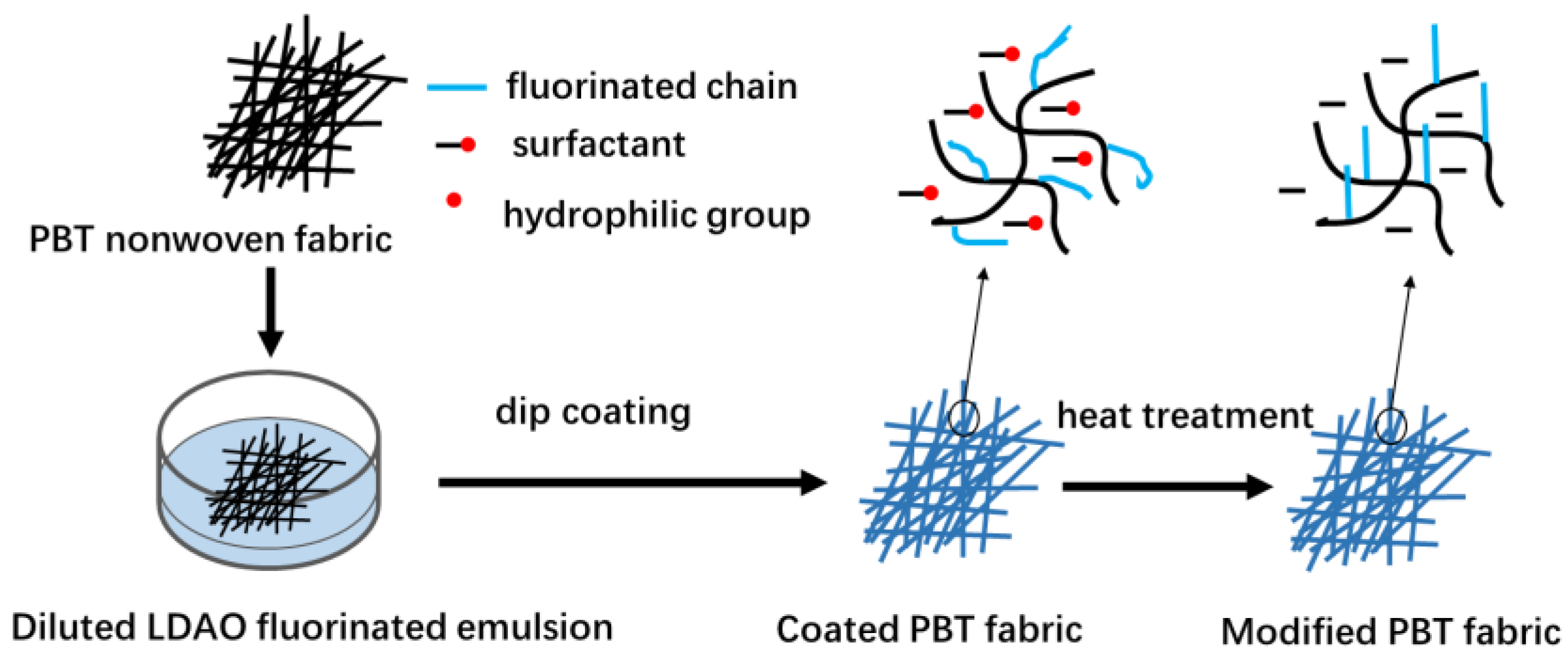

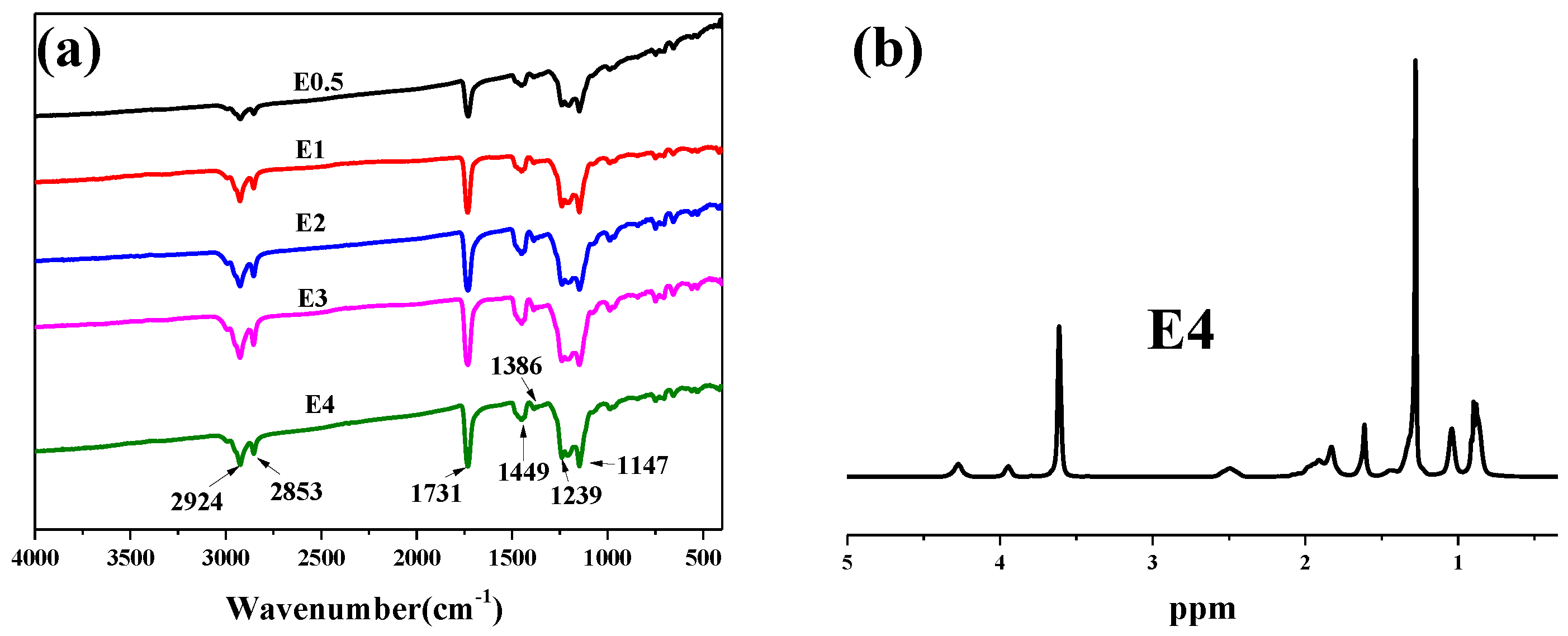
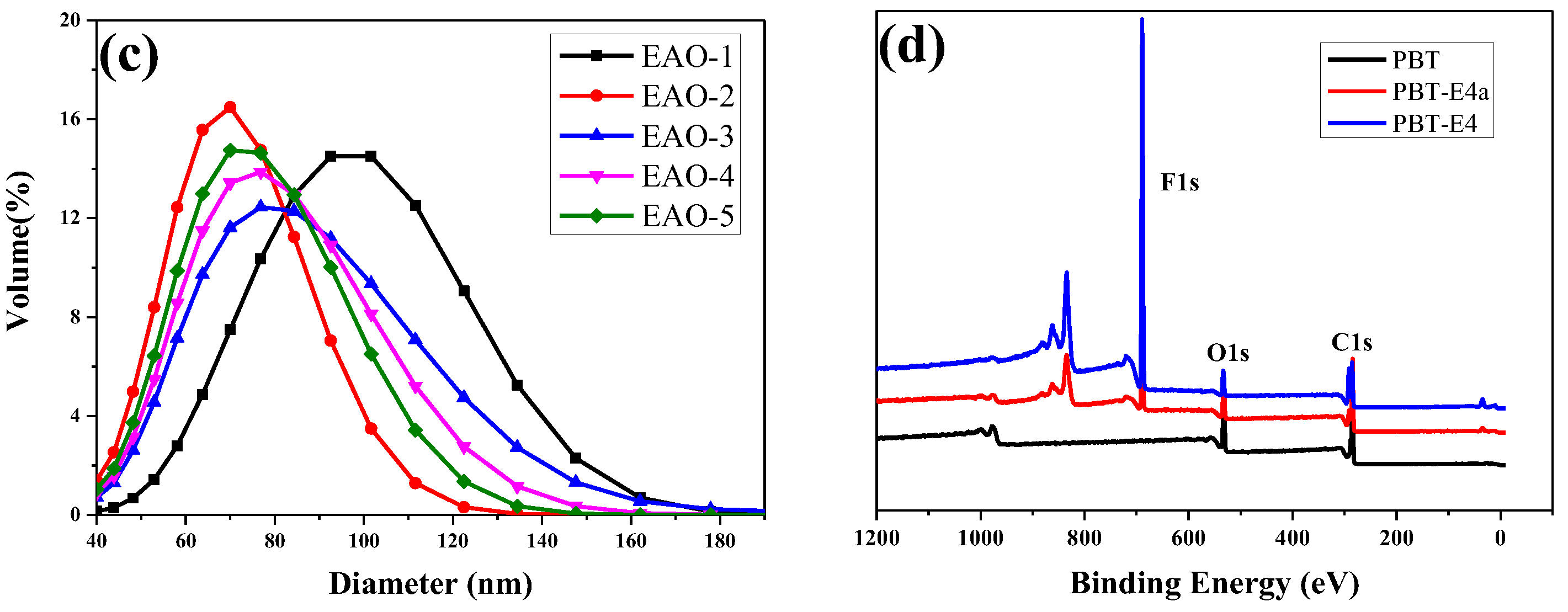
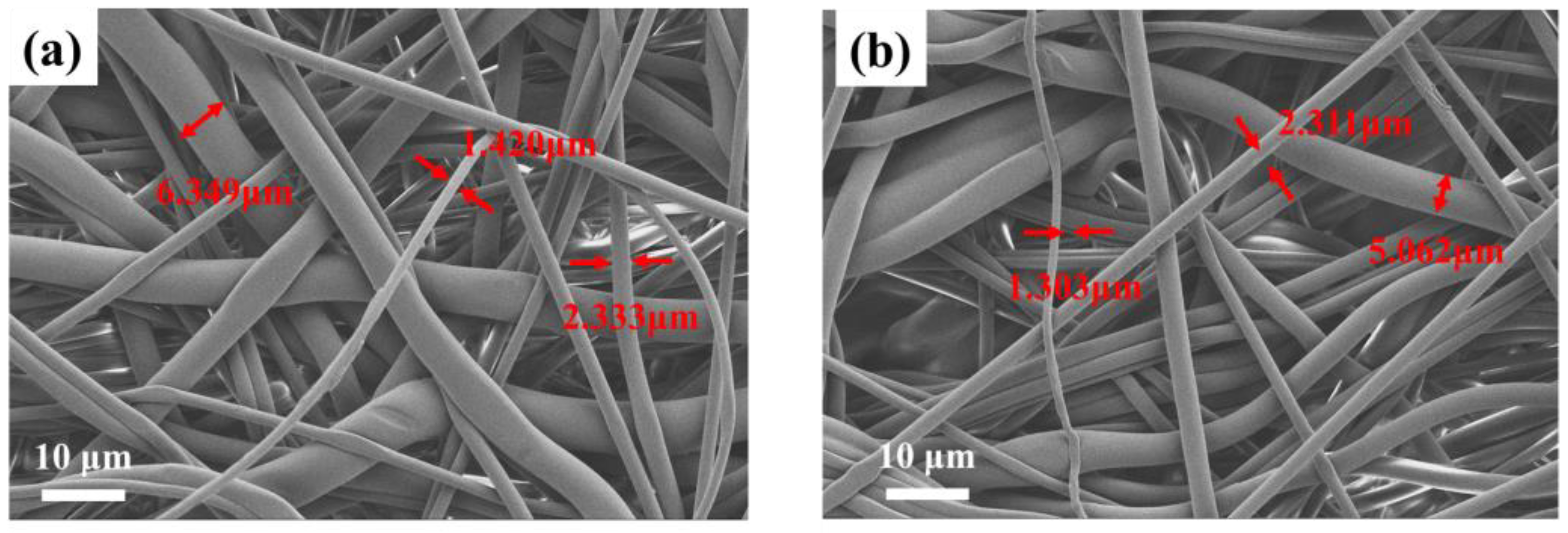
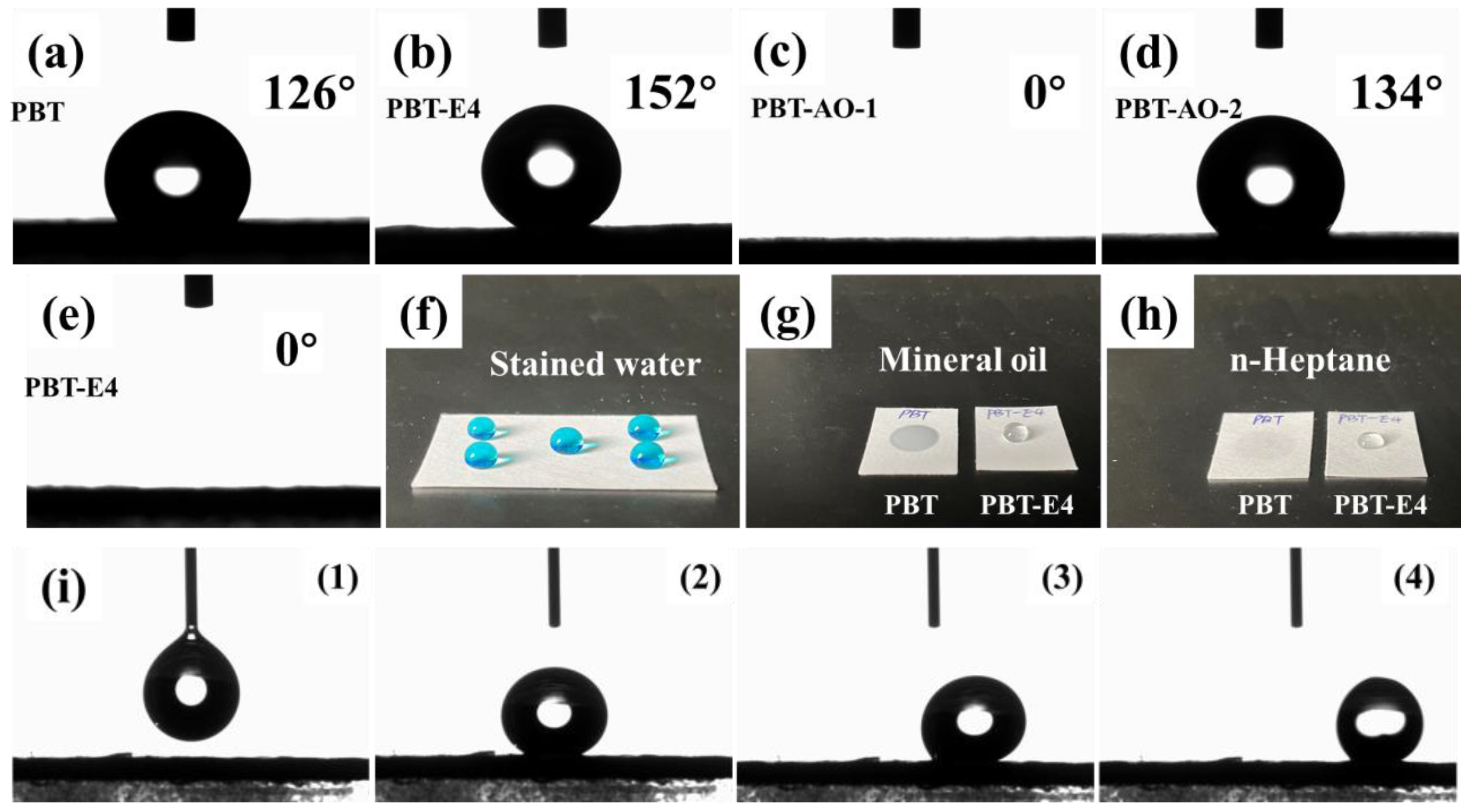
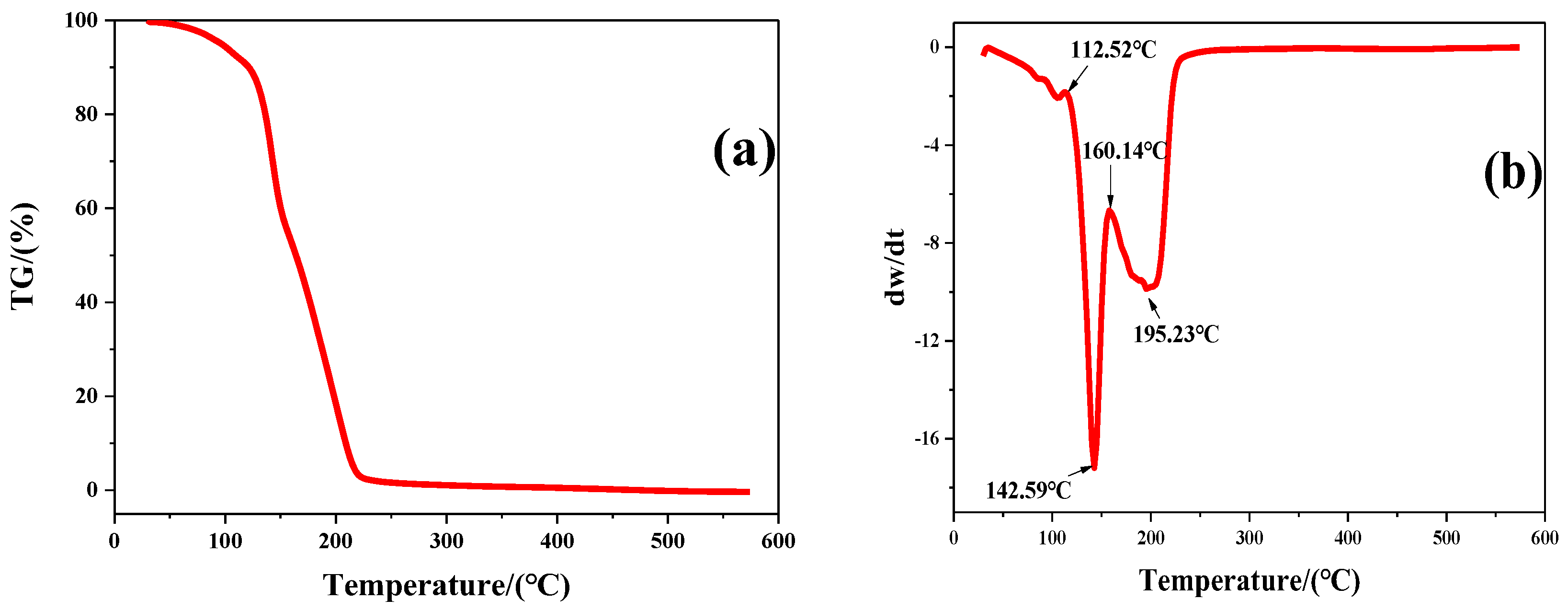
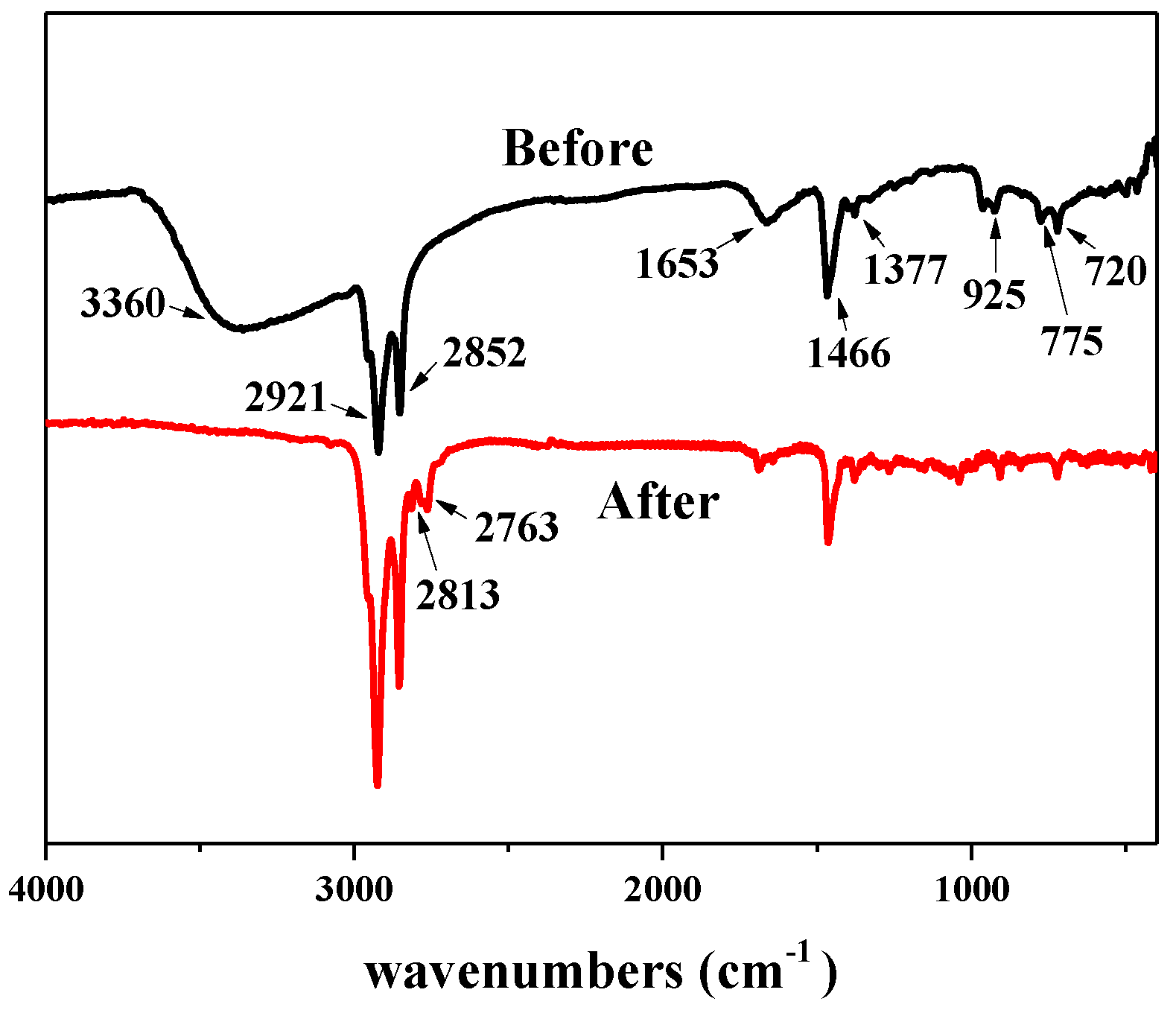

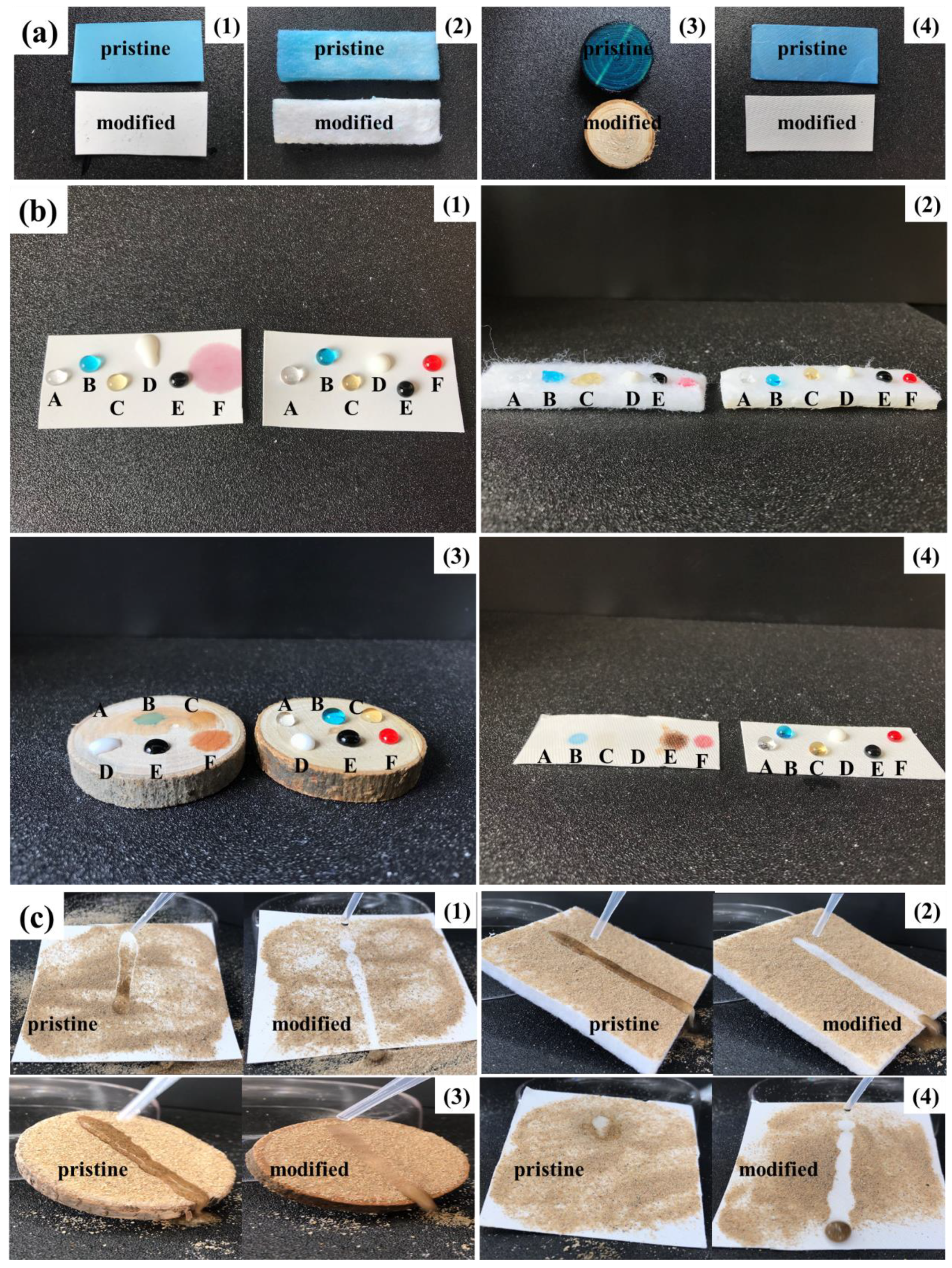

| Sample | Concentration of LDAO (wt.%) | Monomer Conversion (%) | Diameter (nm) |
|---|---|---|---|
| E0.5 | 0.5 | 82.18% | 93.2 ± 1.9 |
| E1 | 1 | 96.28% | 69.4 ± 2.2 |
| E2 | 2 | 98.98% | 76.1 ± 1.4 |
| E3 | 3 | 100.94% | 74.1 ± 3.5 |
| E4 | 4 | 96.74% | 69.2 ± 0.9 |
| Sample | Surface Concentration (at%) | |||
|---|---|---|---|---|
| C | O | F | N | |
| PBT | 74.19 | 25.81 | - | - |
| PBT-E4a | 53.99 | 10.70 | 35.23 | 0.08 |
| PBT-E4 | 40.12 | 5.68 | 54.19 | - |
| Sample | ΔP Value (kPa) | η (%) a | Time b | |
|---|---|---|---|---|
| Immersion in Diethylamine Solution | Immersion in Other Solutions c | |||
| PBT-E0.5 | 27 | 0 | 3 days | Non-wetted |
| PBT-E1 | 26 | 0 | 3 days | Non-wetted |
| PBT-E2 | 26 | 2.5 ± 1.4 | 3 days | Non-wetted |
| PBT-E3 | 25 | 15 ± 1.2 | 3 days | Non-wetted |
| PBT-E4 | 27 | 16.7 ± 2.3 | 3 days | Non-wetted |
| PBT-ES | 18 | 67.7 ± 3.4 | 2 h | 2 h |
| PBT | 11 | 100 | 2 h | 2 h |
Disclaimer/Publisher’s Note: The statements, opinions and data contained in all publications are solely those of the individual author(s) and contributor(s) and not of MDPI and/or the editor(s). MDPI and/or the editor(s) disclaim responsibility for any injury to people or property resulting from any ideas, methods, instructions or products referred to in the content. |
© 2024 by the authors. Licensee MDPI, Basel, Switzerland. This article is an open access article distributed under the terms and conditions of the Creative Commons Attribution (CC BY) license (https://creativecommons.org/licenses/by/4.0/).
Share and Cite
Zhang, B.; Zhang, H.; Ren, Q.; He, B.; Zhang, Y.; Jiang, Z. Fabrication of Corrosion-Resistant Superhydrophobic Coatings and Impermeable Porous Structures Using Fluorinated Microemulsions Containing Thermally Decomposable Surfactants. Coatings 2024, 14, 1176. https://doi.org/10.3390/coatings14091176
Zhang B, Zhang H, Ren Q, He B, Zhang Y, Jiang Z. Fabrication of Corrosion-Resistant Superhydrophobic Coatings and Impermeable Porous Structures Using Fluorinated Microemulsions Containing Thermally Decomposable Surfactants. Coatings. 2024; 14(9):1176. https://doi.org/10.3390/coatings14091176
Chicago/Turabian StyleZhang, Bin, Hongen Zhang, Qiang Ren, Bei He, Yi Zhang, and Zhengwu Jiang. 2024. "Fabrication of Corrosion-Resistant Superhydrophobic Coatings and Impermeable Porous Structures Using Fluorinated Microemulsions Containing Thermally Decomposable Surfactants" Coatings 14, no. 9: 1176. https://doi.org/10.3390/coatings14091176
APA StyleZhang, B., Zhang, H., Ren, Q., He, B., Zhang, Y., & Jiang, Z. (2024). Fabrication of Corrosion-Resistant Superhydrophobic Coatings and Impermeable Porous Structures Using Fluorinated Microemulsions Containing Thermally Decomposable Surfactants. Coatings, 14(9), 1176. https://doi.org/10.3390/coatings14091176








